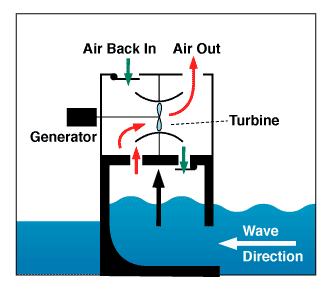Renewable Energy/Wave Energy
Introduction[edit | edit source]
It is no secret that Ocean covers 71 percent of the Earth's surface. While it is not economically feasible to try and harness all the ocean wave energy due to varying amount of wave energy available to harness in different parts of the ocean and the distance it has to travel to be used on land, it is still a very attractive option to consider.
Potential[edit | edit source]
Ocean waves is a renewable energy created by wind currents passing over open water. One of the advantages it has over wind energy is that while wind energy is unpredictable at times, wave energy at given location can be predicted several days in advance so electric providers know how much energy they are going to get from wave energy. The total annual average wave energy off the US coastlines at 60 meter below surface level is estimated at 2100 Terawatt-hours, which is about 20 percent of current energy demand. Even if only a fraction of that energy is recovered, it will still be significant. Because it does not take up any of our already limited land space, so tapping into this relatively untouched and infinite resources could be one of the solutions to our energy crisis with growing population.
How it Works[edit | edit source]
Wave energy is harnessed by using the kinetic (moving motion) energy of the wave to move a piston or a turbine which is then translated back to potential energy that can be used as electricity.

In the simple example above, when the wave rises into a chamber, the water forces the air out of the chamber. This moving air spins a turbine which turns into energy to power the generator. As the wave goes down, air flows back into the chamber through the turbine.
Challenges[edit | edit source]
Like many other renewable energy technology, the biggest problem wave energy faces is the cost. The fact that the technology is new makes it more expensive than traditional source of energy such as coal or oil and even other renewable energies such as nuclear or solar energy. But as the technology matures and the cost of production drops, it will develop into a competitive renewable source of energy.
References[edit | edit source]
U.S. Department of the Interior. Technology White Paper on Wave Energy Potential on the U.S. Outer Continental Shelf. Web. <http://ocsenergy.anl.gov/documents/docs/OCS_EIS_WhitePaper_Wave.pdf>.
Ocean Energy." Energy Story. N.p., n.d. Web. 15 Nov 2011. <http://www.energyquest.ca.gov/story/chapter14.html>.